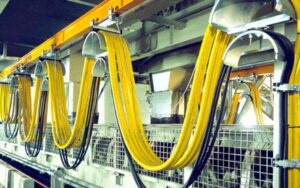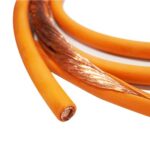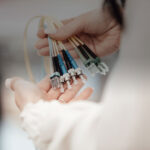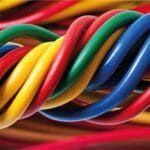If you’ve ever seen an overhead crane or automated storage system in motion, you may have noticed a series of cables hanging in smooth loops, gliding along a track as the machine moves. This distinctive setup is known as a Festoon Cable System — an efficient, reliable way to deliver power, control signals, or data to moving equipment along a defined path.

Festoon Cable System
In this guide, we’ll break down the concept of festooning, explain what a Festoon Cable is, look at its main components such as trolleys, hangers, and flat festoon cables, compare it with other mobile cable systems like reeling cables and trailing cables, and explore its applications in industrial environments.
1. What Does “Festoon” Mean?
The term festoon comes from the French feston and Italian festone, meaning a decorative garland or ribbon draped between two points. In the electrical and mechanical world, festooning refers to the arrangement of cables or hoses in hanging loops along a track, allowing them to extend and retract smoothly as machinery moves.
Industrial Meaning
In industrial settings, “festoon” describes a system where cables (or hoses) are supported and guided by small trolleys that travel along a track or beam. The loops allow for controlled movement without pulling, tangling, or dragging on the floor, making it ideal for environments with repetitive, linear motion.
2. What Is a Festoon Cable?
A Festoon Cable is a specially designed cable intended for suspension in a festoon system. It is engineered to withstand:
Frequent flexing without internal conductor damage.
Abrasion from movement along trolleys and hangers.
Mechanical stress from hanging loops.
Outdoor exposure (UV, moisture) in port and crane applications.
Festoon cables are available in both flat and round designs, with flat cables being more common for their stability and twist resistance in motion.
3. How a Festoon Cable System Works
A festoon system typically consists of:
Track or Rail – The fixed path along which trolleys move.
Festoon Trolleys – Small wheeled carriers that hold and move the cable.
Hangers or Saddles – Support components attached to the trolleys that cradle the cable.
End Clamps – Fixed points where the cable is anchored at both ends.
Festoon Cable – Suspended in loops between the trolleys.
Step-by-step operation:
As the machine moves, the trolleys glide along the track.
The cable loops either extend or fold depending on the direction of movement.
This motion avoids dragging or excessive bending, extending the cable’s lifespan.
(Insert diagram: Track → Trolleys → Cable loops)
4. Core Components Explained
4.1 Festoon Trolleys
Function: Carry the weight of the cable and move it along the track.
Types:
Roller/Bearing Trolleys – Smooth motion for heavy loads.
Nylon-Wheel Trolleys – Lightweight and corrosion-resistant.
Selection factors: Load capacity, travel speed, environment (indoor/outdoor), track type.
[Read more: Festoon Cable Trolley Selection Guide]
4.2 Festoon Hangers
Function: Hold the cable securely and distribute weight evenly.
Types: Saddle-type, clamp-type.
Spacing: Typically every 3–5 ft (1–1.5 m) depending on cable weight and flexibility.
4.3 Flat Festoon Cable
Advantages:
Space-saving profile.
Twist-free motion (important for control and signal cables).
Better flex life than equivalent round cables in suspended systems.
Applications: Cranes, conveyors, automated storage systems.
[Read more: Advantages of Flat Festoon Cable]
4.4 Track / Rail
Options: C-track, I-beam, square bar track.
Material: Galvanized steel, stainless steel, or aluminum.
Considerations: Load rating, corrosion resistance, ease of installation.
5. Key Applications
| Application | Purpose of Festoon System | Typical Environment |
|---|---|---|
| Overhead Cranes | Power and control supply to trolley/bridge | Factories, warehouses |
| Gantry Cranes | Power to moving hoists and beams | Ports, shipyards |
| AS/RS Systems | Power/data to automated stacker cranes | Logistics centers |
| Stage Equipment | Power to lighting and moving props | Theatres, events |
6. Festoon Cable vs Other Mobile Cable Systems
Festoon Cable vs. Reeling Cable
| Feature | Festoon Cable | Reeling Cable |
|---|---|---|
| Movement Path | Fixed track | Any direction |
| Installation | Overhead/side | Cable drum |
| Best For | Linear motion | Circular/multi-axis motion |
| Maintenance | Low | Moderate–High |
| Initial Cost | Low–Moderate | Higher |
Festoon Cable vs. Trailing Cable
| Feature | Festoon Cable | Trailing Cable |
|---|---|---|
| Cable Position | Suspended | On the ground |
| Wear Factor | Low (no ground drag) | High (abrasion on floor) |
| Ideal Use | Overhead cranes | Mobile ground machinery |
[Read more: Reeling Cable vs. Festoon Cable — How to Choose]
7. Selection Checklist
Before specifying a festoon system, consider:
Cable type (flat vs. round, conductor size, insulation).
Total load weight.
Travel length & speed.
Environment (temperature, humidity, chemicals, outdoor exposure).
Voltage & current rating.
Safety factor for load and motion.
8. Maintenance & Safety Tips
Inspect cable jackets for wear or cracks every 3–6 months.
Check trolley wheels and bearings for smooth motion.
Ensure hangers maintain proper loop radius.
Replace damaged components immediately to prevent downtime.
Conclusion
A Festoon Cable System offers a robust, low-maintenance solution for delivering power, control, or data to moving equipment along a fixed path. With the right selection of components — from trolleys and hangers to flat cables — you can maximize performance and cable lifespan in demanding industrial environments.
Whether you’re designing for a crane, a conveyor, or an automated storage system, understanding the fundamentals of festooning will help you choose the most efficient and cost-effective solution.





